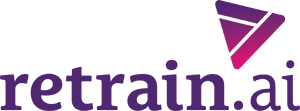HR Technology Conference, the leading industry event this year, provided a genuine look at the biggest challenges for HR leaders and shed light on how the industry is shifting.
retrain.ai was honored to be a part of this global event and recognized by Josh Bersin as one of the leading companies building solutions in the talent intelligence category and helping teams prepare for the future of work.
Here are our key takeaways from the conference, and the major trends to look out for going forward:
1. The Great Resignation – Employee retention is a big problem
From March 2021 to July 2021, a record 19 million Americans quit their jobs. Known as “The Great Resignation”, this post-pandemic period is marked by significant employee turnover – seeing monthly quit rates reaching 2.9%. In contrast, the same period in 2020 saw 13 million Americans quit their jobs, making this year unprecedented.
Remote and hybrid work practices continue to change business practices, and employees are re-evaluating their career plans and looking for jobs that align with their values.
Recent surveys show that 55% of Americans are seeking to change jobs, citing career development and flexibility as the top reasons. Almost 60% of employers surveyed in North America expect their current employee retention problems to continue into 2022, compared to 15% surveyed last year. Organizations are now at greater risk of losing valuable employees, as well as gains in productivity and innovation.
To prevent increasing employee attrition, companies can provide occupational horizons and career navigation tools to show employees possible career paths within the organization. Providing L&D opportunities to upskill or reskill employees fosters a sense of future-proofing and encourages employees to acquire new skills for emerging employment opportunities.
retrain.ai helps facilitate internal mobility and increases employees retention by connecting employees with personalized, dynamic career journeys and L&D opportunities.
Our career and skill insights decrease attrition and reduce hiring costs, by improving employees’ career growth within the company.
2. Skills taxonomies are the next big thing
In the past year, there has been an explosion of vendors with “skills” platforms, from traditional vendors to new companies. These systems span skills taken from employee learning data, recruitment and applicant tracking systems, content providers such as LinkedIn, external skill libraries, and more. However, these current systems lack a robust and integrated framework.
retrain.ai’s system dissects multiple data sources by skills and real-time data, providing a robust skills language to structure every organization’s job descriptions, hierarchies, and tasks. An efficient skills taxonomy is the DNA of the workforce, ensuring that the best people are in the right positions. retrain.ai’s skills architecture distinguishes the many different types of job descriptions available today, allowing organizations to quickly match their own employees’ skills inventory with it and accurately understand their workforce.
3. War for talent
The US is experiencing a hiring boom. As of August 2021, the Bureau of Labor Statistics reported 10.4 million job openings. Job search sites such as LinkedIn also reported a 35% increase in job postings compared to the same time last year. There’s just one problem: there are not enough qualified workers. Jobs such as cybersecurity specialists, full-stack developers, healthcare support staff, customer assistants, truck drivers, sales and business development professionals, among others, are in-demand, but companies are struggling to fill these positions. Currently, almost 73% of companies are facing challenges in finding workers with the right skills, compared to 14% in 2010.
In this tightening labor market, organizations are rapidly competing for top talent. Large companies from Walmart to FedEx are increasing hourly wages in an attempt to recruit workers, and other companies are advertising more flexible and remote work positions. The job search engine ZipRecruiter even saw a 9% jump in the number of employers advertising flexible work arrangements, in order to fill their urgent hiring needs.
As occupations continue to transform due to new technologies, BPO firm Cognizant predicts that new jobs will emerge, including “AI Business Development Managers” and “Data Detectives”. This means that hiring challenges are not going away anytime soon.
In the long run, companies need a resilient strategy to reduce the mismatch between talent demand and supply. retrain.ai helps organizations fill hard-to-hire roles by identifying the right and diverse employees with the right skills. Through our supply and demand mapping tools, organizations can effectively drive employee learning and mobility to meet their talent needs.
4. Diversity & Inclusion at the center
In 2021, 46% of companies are increasing their HR budgets to invest in D&I as a key priority. Overall, 57% of companies plan to focus on D&I initiatives over the next 12-18 months, recognizing the importance of inclusion in the workplace.
Abby Wambach, the opening keynote speaker at HR Tech 2021, echoed the importance of HR’s role in creating an inclusive workforce: “…human resources professionals are a safe haven for people. You deal with a lot of stuff, some that is very hard but is necessary. Not many people can do this.” Wambach, an Olympic gold medalist and equality activist, emphasized how HR can transform how companies navigate the changing realities of work, by promoting DEI and leadership development.
Leading a successful diversity & inclusion strategy requires accurate data to quantify diversity gaps and actionable tools to close them.
retrain.ai provides diversity & inclusion analytics and management tools at all stages of the talent lifecycle. By anchoring talent management to skills, the platform enables companies to reduce biases, maximize talent potential and make accurate workforce decisions.
Summary
As companies look closely at their talent management strategies for 2022 and beyond, their biggest challenges revolve around one goal – having the right data.
Skills-based talent management is taking the lead across almost all aspects of the employee lifecycle and helps to create a future-proof workforce in a rapidly changing job market.
Data Sources
14% of companies struggling to fill jobs in 2010: https://www.prnewswire.com/news-releases/us-talent-shortages-at-ten-year-high-to-attract-and-retain-the-best-talent-employers-need-to-understand-what-workers-want-301000757.html
“Almost 60% of employers surveyed in North America expect their current employee retention problems to continue into 2022, compared to 15% surveyed last year:”
“As of August 2021, the Bureau of Labor Statistics reported 10.4 million job openings:” https://www.bls.gov/news.release/pdf/jolts.pdf
“LinkedIn also reported a 35% increase in job postings compared to the same time last year:”
https://economicgraph.linkedin.com/resources/linkedin-workforce-report-september-2021
In-demand jobs: https://www.linkedin.com/business/talent/blog/talent-strategy/most-in-demand-jobs
“46% of companies investing in D&I as a key priority:” https://www.pwc.com/us/en/library/pulse-survey/future-of-work.html










